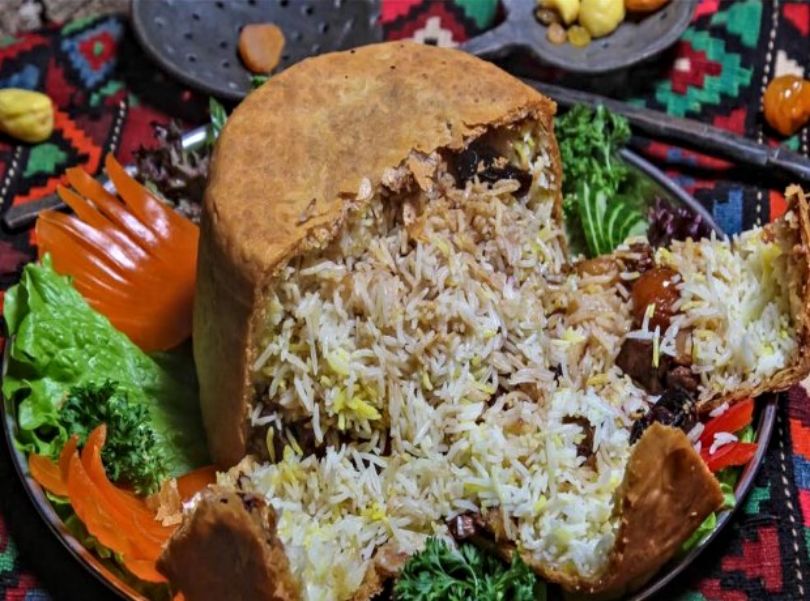Pilaf (or Plov) – The king of our celebration tables in Azerbaijan. Plov will be prepared for the special occasionssuch asholidays, family celebrations, etc.If you will invite the guests to visit your home, the dining table may not be without Plov. You will show your respect to your guest with Plov and show guests importance. In contrast to the Uzbek plov, Azerbaijani plov will not be mixed with vegetables, meat and chicken.By pilaf served fried and side dishes. So just come and watch.Better to see once than hear a hundred times!
Pilaf
Rishta plov – Noodle pilaf
Lamb stew with chestnuts and dried fruit
Chicken pilaf
Lobya Chilo – Bean pilaf
Sweet pilaf
Parcha doshama – Lamb under rice
Fsinjan pilaf
Plov with pumpkin
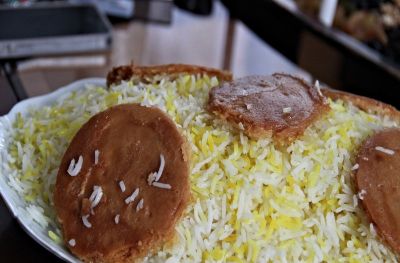
Necessary Products:
To 2 persons
- 1 Cup = 220 ml
- 1 cup of Basmati Rice to 2 persons
- 3 cup of water
- 2 tea spoon of salt
- 100 gr. Butter (not oil)
- 15 thread of saffron
Preparation:
Begin with the rice from evening before preparing. Rinse the rice in cold water several times to remove excess starch. Pour cold water into the bowl with the cleaned rice. Let it be min. 8 hours or overnight.
Before you begin with rice cooking, about 1-2 hours before, prepare saffron extract. Put a few threads of saffron in a cup and add boiling water. Cover and leave to infuse. (Would you like to make this dish together? Join our Cooking Masterclasses to learn and taste the national cuisine of Azerbaijan!)
Fill a large, heavy pot with water and add salt. Bring to the boil. Add the rice to the boiling water. Cook the rice approx. 5-10 minutes. Be careful not to cook for too long or the finished rice will be sticky. To see if the rice is ready, take a couple of grains out of the pot and test them on your finger. The grain should be soft on the outside, but still firm on the inside. When you bite into the grain or break it with a finger nail, the hard white interior should still be visible.
Strain the rice through a rice colander.
Take the same pot, put some butter in the bottom of the pot and put gazmakh or lavash. I will explain how you can do gazmakh in another recipe. You can also use potatoes instead of gazmakh or lavash. Add the parboiled rice into the pot. Put several knobs of butter on top. Make holes in the rice with the handle of a wooden spoon to allow the steam to escape. Place a well-fitting lid on top of the pot, covered underneath with a clean tea towel. The towel helps to absorb the steam. Set the cooker on the lowest flame. After 5-10 minutes open the pot, put remaining butter on the rice, pour saffron extract and place the lid again on the pot.
Continue steaming of the rice for 45-60 minutes. Plov is ready, when the rice is stuck out.
Serve Plov on a large dish. Pour the golden rice on the top of remaining rice. The rice should be an attractive combination of yellow and white. Serve the qazmaq in pieces on top of the rice or separately. Plov serveddifferentfries, f.x. sebzi-govurma.
Nush olsun! Bon appetite!
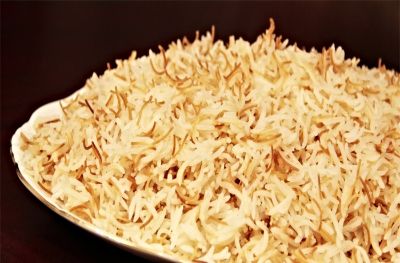
Azerbaijani cuisine has a rich variety of pilaf dishes and sauces to go with them. Noodle pilaf is a particularly filling pilaf and can be served on its own or with chicken. As with all Azerbaijani pilafs, noodle pilaf should not be sticky! It follows the basic cooking method for rice – to parboil it and then steam it.
Necessary Products:
- 1 Cup = 220 ml
- 1 cup of Basmati Rice to 2 persons
- 0,5 cup short noodles
- 4 cup of water
- 2-2,5 tea spoon of salt
- 100 gr. Butter (not oil)
Preparation:
Fry the noodles in a pan without oil until golden (about 5 to 10 minutes).
Fill a large, heavy saucepan with water and add salt. Bring to the boil. Add the rice to the boiling water. Turn the heat down slightly but cook at a rapid boil for 5 to 10 minutes. Be careful not to cook for too long or the finished rice will be sticky. To see if the rice is ready, take a couple of grains out of the pot and test them on your wet finger. The grain should be soft on the outside but still firm on the inside. When you bite into the grain or break it with a finger nail, the hard white interior should still be visible. Before you strain the rice, add the noodles and leave to simmer in the water for 2 to 3 minutes.
Strain the rice and noodles through a rice colander.
Rinse and dry the rice pan. Return it to the heat and melt a generous knob of butter. Spread the qazmaq mixture or lavash over the bottom of the pan.
Add the parboiled rice and noodles to the pan. Put several knobs of butter on top. Make holes in the rice with the handle of a wooden spoon to allow the steam to escape. Place a well-fitting lid on top of the saucepan, covered underneath with a clean tea towel. The towel helps to absorb the steam. Once the rice is steaming, turn down the heat and leave to continue steaming for 30 to 45 minutes. The rice can be left to steam for longer without coming to any harm.
Serve on a large dish with the qazmaq in pieces on top of the rice or separately.
Nush olsun! Bon appetite!
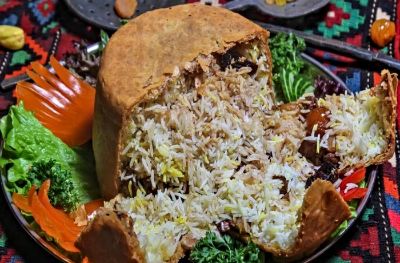
Necessary Products:
- 1 cup rice
- 2 cups stock
- 500g chicken thighs
- 1 onion, diced
- 2 garlic cloves, crushed
- 10 strands of saffron
- ½ cup melted butter
- 1 cup nuts (I used almonds and cashews)
- 2 cup dried fruit (I used apricots, prunes and cherries), diced
- 2 Tbs lemon juice
- ½ tsp paprika
- ½ tsp cumin seeds
- 4 large pieces of flatbread
Preparation:
Preheat oven 200°C
Poach the chicken in a simmering pot of water (or stock) until cooked (about 15 mins). Remove chicken, let it cool and then shred into pieces.
Use any method to cook the rice in about 2 cups of stock (I used a rice cooker).
Combine the saffron and ½ cup hot water in a small container and set aside.
Add 2 Tbs of melted butter, add the diced onions and crushed garlic and cook for 2 mins until soft.
Add the paprika, cumin seeds, nuts, fruit, chicken, saffron water, lemon juice and rice. Stir until combined and liquid has evaporated.
Brush the bottom and sides of a 12-inch ovenproof pot (with a lid) with melted butter
Cut the flatbread into 5 cm strips and brush both sides with melted butter. One piece at a time, lay the flatbread into the pot from the centre up the sides (leaving about 7-8 cm of overhang). Keep adding flatbread until the whole pot in covered
Add the rice mixture to the centre of the pot. Cover the rice with the flatbread overhand.
Bake in the oven for 40 mins covered and then 10 mins uncovered.
When the pilaf is cooked. Carefully but quickly invert the pot onto a serving plate.
Nush olsun! Bon appetite!
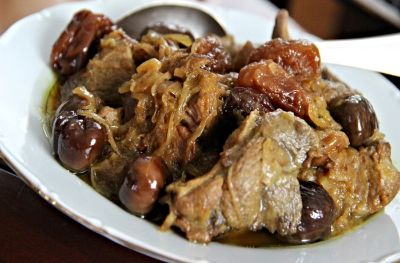
Lamb or veal stew with chestnuts and dried fruit is a very popular Azerbaijani dish, served with rice pilaf.
It is an Azerbaijani version of a sweet and sour dish, although the various names for the dish usually refer either to the sweet or sour element, but not both together. The basic ingredients of the stew are lamb or veal, onions and dried fruit. If a dried plum called albukhara, similar to a dried greengage, is used, the dish is called turshu plov (sour pilaf) or turshu qovurma (sour fried meat). Albukhara are a tangy dried fruit, hence the adjective “sour”. When chestnuts, dried apricots and raisins are also used in the dish it can be called shirin qovurma (sweet fried meat). Shirin plov, however, usually refers to rice with dried fruit but without meat. A general name for the stew in some parts of Azerbaijan is ashin. Sweet and sour lamb or veal stew with chestnuts and dried fruit. We give below a recipe for the stew using albukhara, chestnuts, dried apricots and raisins. Either the apricots or the raisins can be omitted, if you want to reduce the sweetness of the stew. If you cannot get hold of albukhara or a zesty dried plum, use lemon juice instead.
Necessary Products:
- 500 gr lamb
- 5 pieces onion
- 300 gr chestnuts (not shelled)
- 200 gr albukhara, a dried fruit similar to dried greengages or plums. Albukhara have a sharp, tangy flavour.
- Salt & pepper
- Abgora – 1 glass, green grapes soft, or citric acid – 1 tsp. disclosed in 1 glass hot water
- Butter
- Turmeric
Preparation:
Chop the lamb into chunks. Place in a pan of water and bring to the boil. Remove the scum that forms on top. When the meat is soft, remove from the water.
Pierce the chestnuts. Cover with water in a pan and bring to the boil. Simmer for 5 minutes. Remove from the water and shell. Don’t take all the chestnuts out of the water at once, as they are difficult to shell when dry.
Pour boiling water onto the dried plums, soak for 3-4 minutes and drain.
Cut the onion into rings and and fry in butter or oil. Add the meat and stir.
Add the chestnuts, dried fruit, turmeric (if not using saffron) and salt & pepper to the meat and onions and fry for 3 to 4 minutes. Add 3-4 tablespoons of the bouillon from the meat, and abgora of citrix acid, disclosed in hot water with adding turmeric. Simmer for 30 minutes or so. Do not cook for too long or the onions and chestnuts will lose their shape.
Serve with rice pilaf.
Nush olsun! Bon appetite!
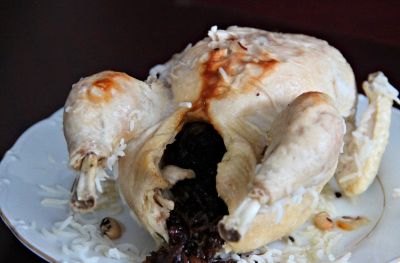
Everyone must have tried cooked chicken. But not many have tried chicken cooked using the special method, i.e. under rice. Besides the ingredients you need for plov, you will need the following ingredients:
Necessary Products:
- A whole chicken
- 100g raisins
- 2 medium size onions
- Butter (could use oil instead)
- salt to taste
Preparation:
Wash the chicken, clean (from feather and other inedible parts), put in a pot and add water to almost cover the chicken (but not fully). Add salt to taste. Bring to boil and reduce the heat to medium, remove the froth (skim), cover and half-cook it. It’s important not to fully cook it, otherwise the chicken will ‘fall off’ from bones.
Dice the onions, add salt and cook till golden. Do not overcook as it will become hard. Soak the raisins in boiling hot water for 2 minutes, drain and dry. With knife, cut them in little pieces. Then mix with the fried onions.
Cut the edges of legs and wings from chicken – traditionally, they are not served as they do not look aesthetically nice. Stuff the chicken, through the whole in the chicken, the raisin and onion mixture. Put the chicken in a muslin cloth – this will help to keep the rice from sticking to the chicken. Put aside.
Cook the rice as described in the Plov recipe.
Put some butter in a pot, add lavash or Gazmakh (link?) and add the rice on top covering it all (about 2-2.5cm). Put the chicken in muslin on its backand add the remaining rice. Add more melted butter and 1/8 cup of boiled water.
Put a kitchen towel around the lid of the pot, cover the pot and put on law heat to steam. Please note, normally saffron water is not added to Chicken plov. It also takes longer to steam this plov as compared to plov without rice. This rice requires a larger pot. When I cook Chicken plov, I always make plov in a different pot where I can add saffron water.
Once rice is ready to be served, put the rice that is on top of the chicken on a serving dish, add saffron rice to decorate. Take the chicken out, remove the muslin cloth. Serve together. The success is guaranteed. In addition to knife and fork, put a desert spoon on the table for the stuffing.
Traditionally, the rice underneath the chicken is not served to guests. But to be honest, this rice is very tasty as all the juices of the chicken covered it and cooked the rice.
Nush olsun! Bon appetite!
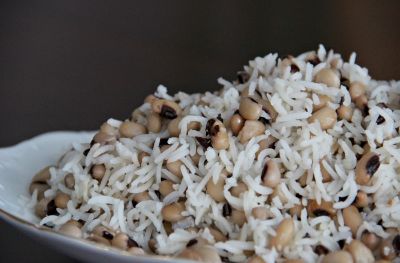
This is a favourite pilaf tish. It is usually cooked for celebration of the last Tuesday before Novruz, holiday of spring. It is usually served with salty fish. It can also be served with fried pumpkin pieces, if pumpkin is available. Which means the plov can be served with salty or sweet accompaniment. My mum likes to add sugar on top of her plate of this plov when we make it while I prefer salty version
Necessary Products:
- 2 cups of rice
- 2 cups of haricot or aduki beans
- Butter
- Salt
- Dried fish to garnish
Preparation:
Soak beans and rice over night. Boil beans in salted water till they are cooked. Empty the water and put aside.
Cook rice in boiling water al dente (see how to make Plov).
Take an empty pot, add some melted butter, add some beans and rice, mix together and spread evenly on the bottom of the pot.
Add some more rice and spread in the pot, then do the same with the beans. Continue alternating layers of rice and beans. The last layer must always be rice. Add some water (2 tbsp) and butter, cover the pot with a lid covered with a tea towel. Leave the rice steam till it’s ready.
When the rice is ready, mixed the rice and beans together. It is ready to be served
For garnish, while rice is steaming, cut the fish into pieces and wash. Boil the fish in a pot for about 15 minutes. Fish should be ready at the same time as plov. Serve everything hot.
Nush olsun! Bon appetite!
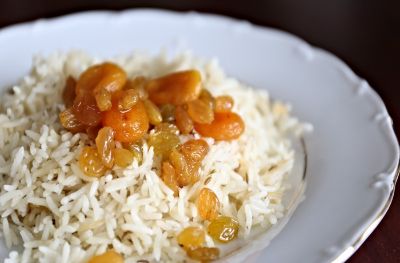
Necessary Products:
You need:
- Equal quantities of dried apricots and sultanas
- Melted butter – 1tbs
- beef stock or usual water – 2tbs
Preparation:
Wash and dry the apricots and sultanas. Half the apricots.
Put them in a pan, add the butter and stock. Put the lid on and leave to cook on low heat. Important: do not fry. If you see that the stock is fully absorbed, add another spoonful of stock. Stew the dried fruit on low heat for approximately 30-45 minutes. The dried fruit will grow in size by absorbing not only the stock but also the butter. They will look like jade beads.
Make plov as described here.
Serve the dried fruit on a plate separately from rice. They should be eaten with the plov.
Nush olsun! Bon appetite!
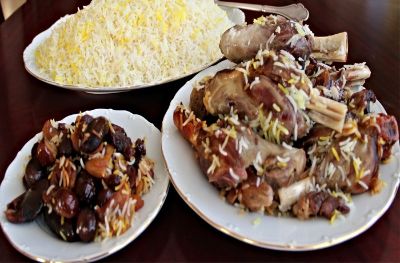
It must be said that Azerbaijani plov is different from rice dishes of other countries by the fact that it is cooked separately from other products and served separately.
Necessary products:
For this plov you will need:
- Lamb shanks (one piece per person)
- Dates
- Chestnuts
- Raisins
- Dried apricots
- Melted butter
- Salt
- Saffron
Preparation:
Parboil the meat for about 30-40 minutes depending on how bit the pieces are.
Wash the dried fruit, keep them in hot water for 2 minutes. Prepare chestnuts the way it is described above - Lamb stew with chestnuts and dried fruit
Infuse saffron in hot water an hour before you start cooking rice. Cook rice as described (we wrote above Plov recipe)
Put the some melted butter in the pot (1-2 tbsp), add the dough for gazmag. On top of the dough add a layer of rice of about 1-2cm high. Then add the lamb shanks and follow with dried fruit.
To avoid mixing the dried fruit and rice, put a muslin cloth or a plate on top of dried fruit.
Add the remaining rice. Pour ¼ cup of water and some melted butter. Make small holes in the rice with the end of a wooden spoon, cover the pot with its lid wrapped with a kitchen towel. Leave on low heat for 10 minutes. Lift the lid, add saffron infusion and melted butter (about 50 gr.) The replace the wrapped lid and leave on very low heat for the rice to fully cook (it took 3-4 hours when I was making it, a bit longer than 1-2 hours that rice without meat takes to cook).
Once rice is cooked, put it in a large serving dish and decorate with gazmag. Meat and dried fruit put on separate plates and serve at the same time. Here is how everything looks.
Serve rice, dried fruit and lamb shanks on individual plates. The meat will be very tender and delicious and will be falling off the bone
Nush olsun! Bon appetite!
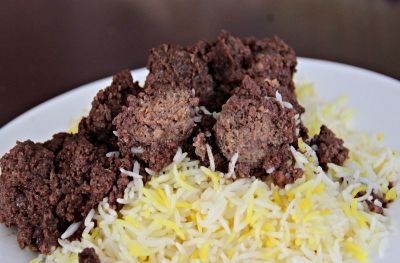
If you’ve been in Baku and tasted this dish, you’ll never forget it. I’m speaking about a brilliant dish of the Azerbaijani cuisine called Fsinjan. It consists of beef meatballs and nut sauce.
Necessary products:
You will need:
- Beef and lamb mins – 500 g
- Diced onions – 250 g
- Walnuts – 350 g
- water – 2-2.5 cup (250 ml)
- citric acid (or lemon juice) – 1 tsp
- salt and pepper to taste
- melted butter
Preparation:
Before starting, I have to warn you that this recipe is mainly used in Baku. Other regions of Azerbaijan have other variations, e.g. they add lavashana – a sour spice made of sour fruit or berries like plums etc. My grandmother used to use abgora – a special juice of unripened green grapes. With times abgora has become a rarity and almost impossible to find, so she started to use what was available – citric acid.
To begin, mix onions and mixed beef and lamb mince, season. Make small meatballs, of the size of a walnut. Fry in butter in a pan. Move into a pot, add some melted butter and leave.
Grind the walnuts. Dissolve tsp each of salt and citric acid in water. Mix well. Empty the water solution in a pan (preferably cast iron pan) and boil. When it starts boiling, add walnuts and constantly stir. If water is absorbed by the nuts or the nut mixture seems too dry, make and add another solution but with less salt and citric acid. If you feel it’s not sour enough, you can add more citric acid. As the nut mixture is cooking I a cast iron pan, the colour of it will become darker. If you do not have a cast iron pan, you can put the plate of your mincer in your pan. You will notice it will help the darkening process of the nut mixture. It doesn’t need to be too dark, around 5-7 minutes will be enough.
Warm the meatballs in the pot till all the butter is melted completely. Empty the nut mixture on top of meatballs and slowly mix. Add some water if you feel that fsinjan is too dry. You can also add more butter if you feel it’s needed. It should cook for about 2 hours on low heat. It is served with plov.
When ready, fsinjan is almost purple colour. It is possible to make fsinjan with chicken. Chicken must be preliminary fried.
Nush olsun! Bon appetite!
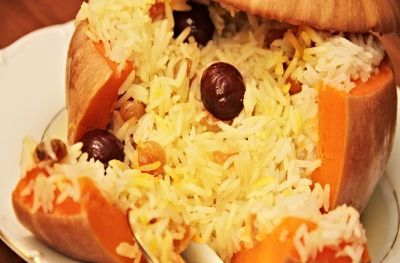
Necessary products:
- Pumpkin – 2kg
- Rice – 1.5 cups
- Butter – 50-75g
- Saffron
- Sultanas, dried apricots, chestnuts
- or cumin
Preparation:
If you pumpkin is bigger than 2kg, you will need to use more rice.
You can make this plov with sultanas, dried apricots, chestnuts or with cumin. If you feel lazy then you don’t even need to add anything. It all depends on what you feel like.
Cut the top part of the pumpkin in a way to create a lid. Remove all seeds etc. Then clean in such a way that there is nothing on the inside of pumpkin. Then, using a table spoon, scrape the internal walls of the pumpkin – it’s the easiest way to clean it.
Taste it. It tastes good when uncooked too. And as well as I know it is also beneficial for health. If you discover it is not sweet, sprinkle 1 tablespoonful of sugar on the walls of the pumpkin. Put a side. Cook rice as described here.
If you decide to make plov with dried fruits and chestnuts, cook and clean the chestnuts from skin in advance. If dried apricots are too big, cut in half. Wash and dry sultanas and dried apricots. Put in a pan together with chestnuts, add some butter and 1 tablespoonful of water. Warm the pan up to the max. Once the butter has melted, reduce the heat to the minimum, cover the pan and fry for 5 to 10 minutes or until the dried fruit become soft. Put aside.
Infuse saffron in hot water 30 minutes before cooking ritce as described here.
When rice is ready and is sieved, move into a bowl, add cubed butter. Add dried fruit and chestnuts (if used). If you are using cumin instead, then add it. Mix rice well. If you don’t use anything, then just stir rice with butter cubes.
Transfer rice inside the pumpkin, poor 1-2 tablespoon of water and saffron infusion. Put the pumpkin ‘lid’ on top.
Wrap the pumpkin into a foil and put into preheated oved (150 degrees). In an hour, increase the temperature to 180-200 degrees. The higher the temperature, the faster the pumpkin cooks. Usually it takes 3 hours. Before serving, open the foil and check the readiness by using fork.
Plov is ready once pumpkin softens. Remove the foil, careful put on a plate. Transfer onto a plate and serve.
Nush olsun! Bon appetite!
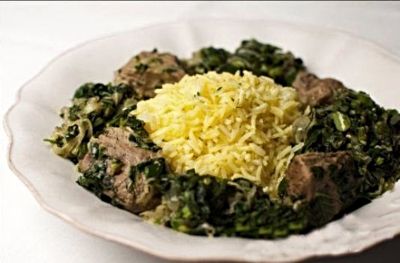
Necessary products:
- rice - 2 cups basmati or other long - grain rice
- peas - 1 cup
- green beans - 1 cup
- carrots - 1 cup, cut into thin round slices
- cauliflowers - 1 cup
- chili peppers - 1 finely chopped
- butter - 2 tbsp
- ginger - 1/2 tsp
- turmeric - 1/2 tsp
- water - 4 1/5 cups (1 liter)
- salt
- tomatoes - 3 ripe, peeled and finely chopped
- bay leaf - 2
- cloves - 6
- cinnamon - 1 stick broken into 1 tsp each
- cumin - 1 tsp seeds
- cardamom - 1 tsp
- garlic - powdered or 2 cloves crushed
Preparation:
Make the last five spices into a little bundle, wrap it in gauze. Wash the rice, soak it for 15 minutes and drain it. Heat the butter in a large pan and fry all the vegetables, excluding the tomatoes, ginger and turmeric, in it. Leave to get braised over high heat for 4-5 minutes.
Add the rice, mix, and add the remaining ingredients + the bundle with spices. When the dish comes to a boil, lower the heat and cap the pot until the rice absorbs all of the water. Remove from the heat and leave it for 7-8 minutes, then pull the bag of spices and bay leaves out. Serve on a hot platter with lemon slices.
Nush olsun ! Bon appetite!

